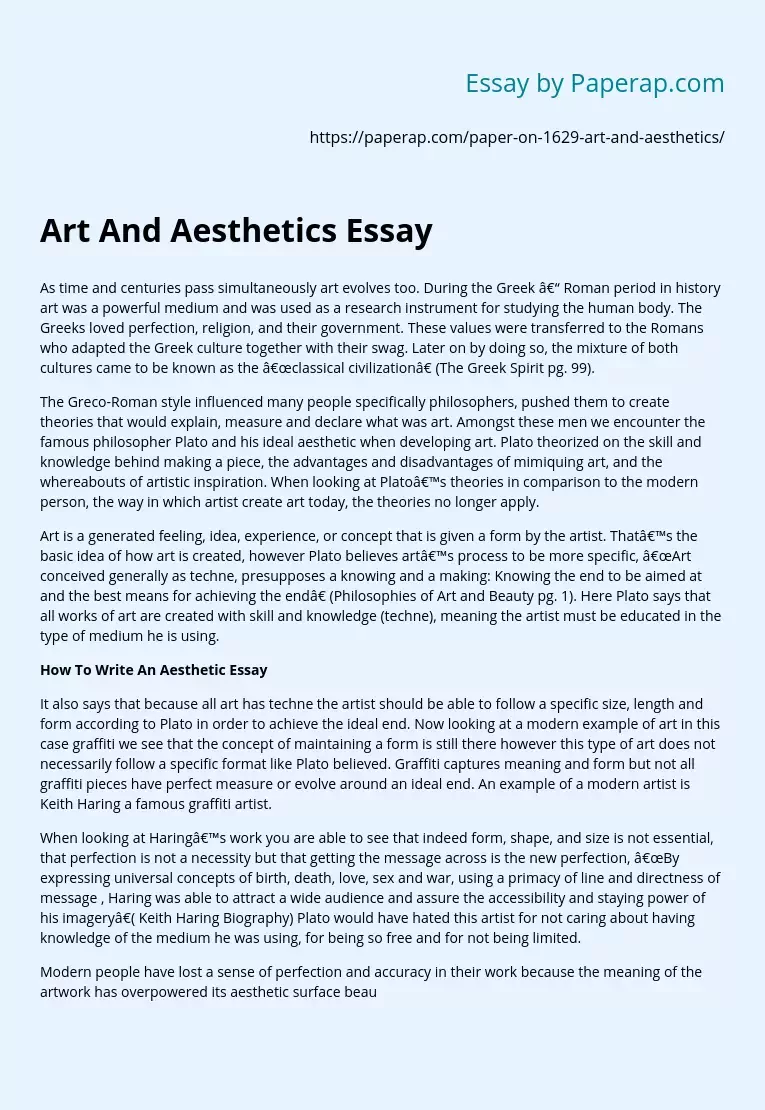Art And Aesthetics Essay
As time and centuries pass simultaneously art evolves too. During the Greek – Roman period in history art was a powerful medium and was used as a research instrument for studying the human body. The Greeks loved perfection, religion, and their government. These values were transferred to the Romans who adapted the Greek culture together with their swag. Later on by doing so, the mixture of both cultures came to be known as the “classical civilization” (The Greek Spirit pg. 99).
The Greco-Roman style influenced many people specifically philosophers, pushed them to create theories that would explain, measure and declare what was art.
Amongst these men we encounter the famous philosopher Plato and his ideal aesthetic when developing art. Plato theorized on the skill and knowledge behind making a piece, the advantages and disadvantages of mimiquing art, and the whereabouts of artistic inspiration. When looking at Plato’s theories in comparison to the modern person, the way in which artist create art today, the theories no longer apply.
Art is a generated feeling, idea, experience, or concept that is given a form by the artist. That’s the basic idea of how art is created, however Plato believes art’s process to be more specific, “Art conceived generally as techne, presupposes a knowing and a making: Knowing the end to be aimed at and the best means for achieving the end” (Philosophies of Art and Beauty pg. 1). Here Plato says that all works of art are created with skill and knowledge (techne), meaning the artist must be educated in the type of medium he is using.
How To Write An Aesthetic Essay
It also says that because all art has techne the artist should be able to follow a specific size, length and form according to Plato in order to achieve the ideal end. Now looking at a modern example of art in this case graffiti we see that the concept of maintaining a form is still there however this type of art does not necessarily follow a specific format like Plato believed. Graffiti captures meaning and form but not all graffiti pieces have perfect measure or evolve around an ideal end. An example of a modern artist is Keith Haring a famous graffiti artist.
When looking at Haring’s work you are able to see that indeed form, shape, and size is not essential, that perfection is not a necessity but that getting the message across is the new perfection, “By expressing universal concepts of birth, death, love, sex and war, using a primacy of line and directness of message , Haring was able to attract a wide audience and assure the accessibility and staying power of his imagery”( Keith Haring Biography) Plato would have hated this artist for not caring about having knowledge of the medium he was using, for being so free and for not being limited.
Modern people have lost a sense of perfection and accuracy in their work because the meaning of the artwork has overpowered its aesthetic surface beauty, this meaning that Plato’s aesthetic theories no longer limit and gear the modern artist towards perfection. Art is the recreation of something that already exists. Plato refers to this as imitating work when he says, “Human makers envisage the human community according to the ideas of justice, the good, courage, temperance, and the beautiful. Within the state the various arts are practiced likewise as imitations of an external order of existence” (Philosophies of Art and Beauty pg. 4)
Plato talks about how human makers see the world according to certain ideas, which pushes them (while thinking this way) to create/practice art even though in the end they are still imitations of something that already exists. Part of Plato’s theory is right yet an artist’s imagination can’t imitate work but it can create work. This theory compared to how the modern person creates art has to in the sense that yes some artist are imitators but at the same time they are makers because they are taking something that already exists ,feeding it a meaning, giving it a personal twist and recreating the piece .
Keith Haring pops at this theory again and challenges it by creating work influenced by social concepts occurring in his human community, “They were humans and animals in different combinations . I remember trying to figure out where this stuff came from but I have no idea. I just grew into this group of drawings. I was thinking about these images as symbols, as a vocabulary of things. Suddenly it made sense to draw on the street, because I had something to say” (Keith Haring Biography).
Art And Aesthetics Essay. (2019, Dec 05). Retrieved from https://paperap.com/paper-on-1629-art-and-aesthetics/

